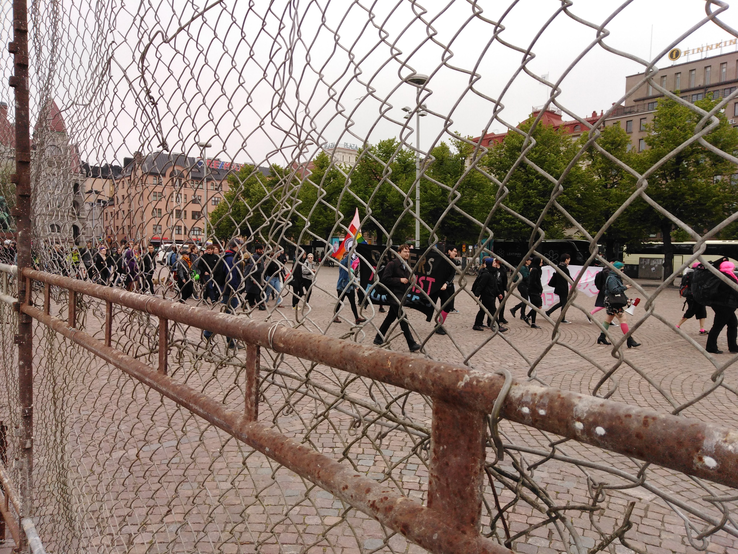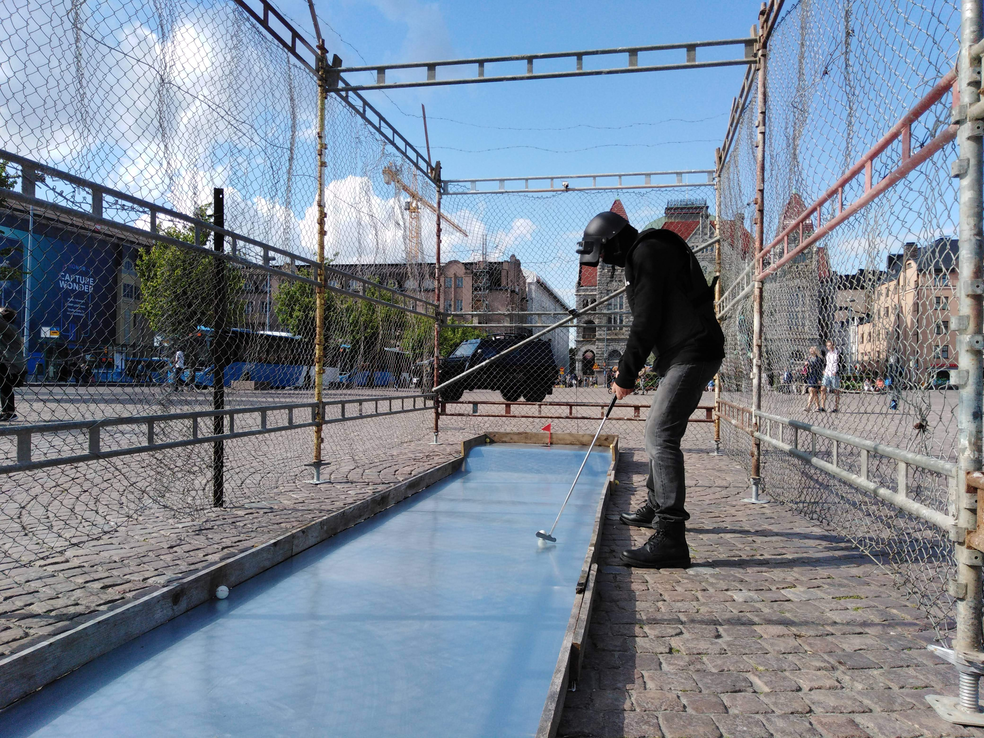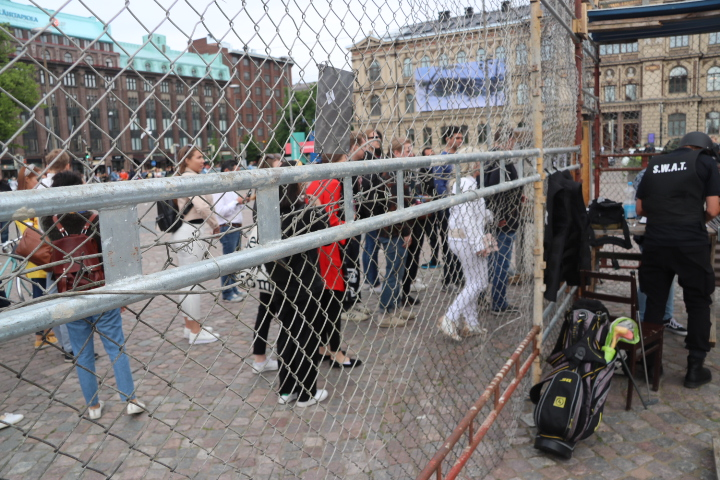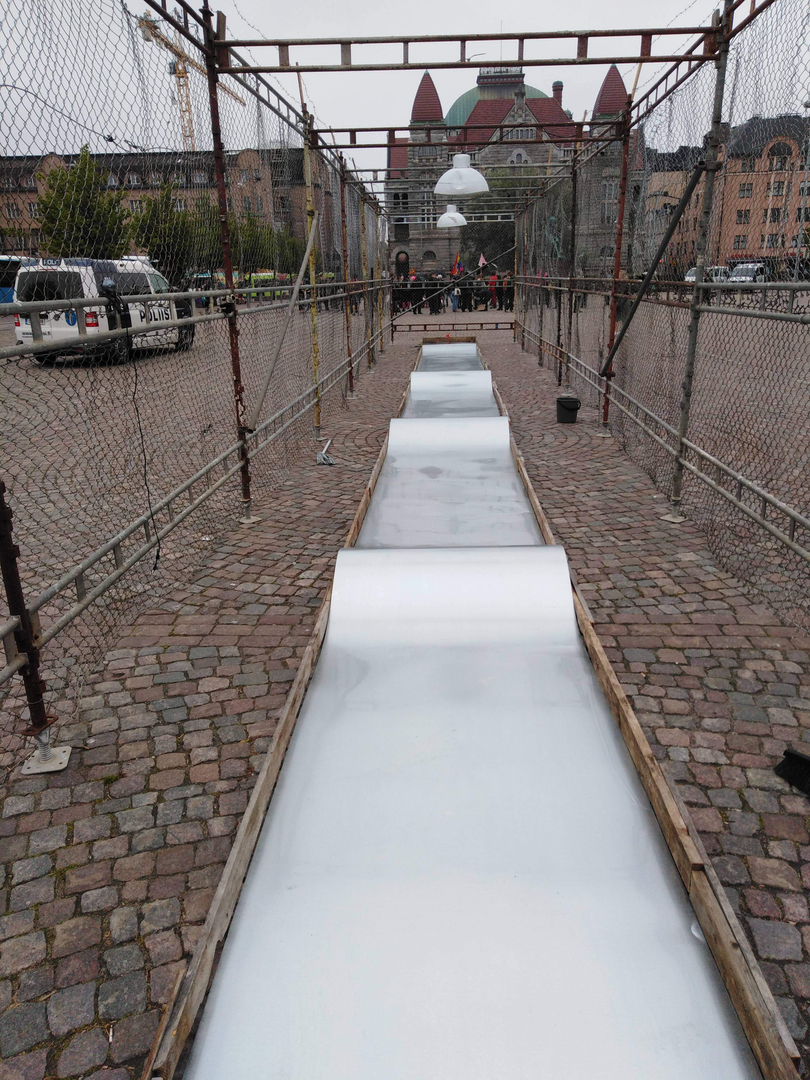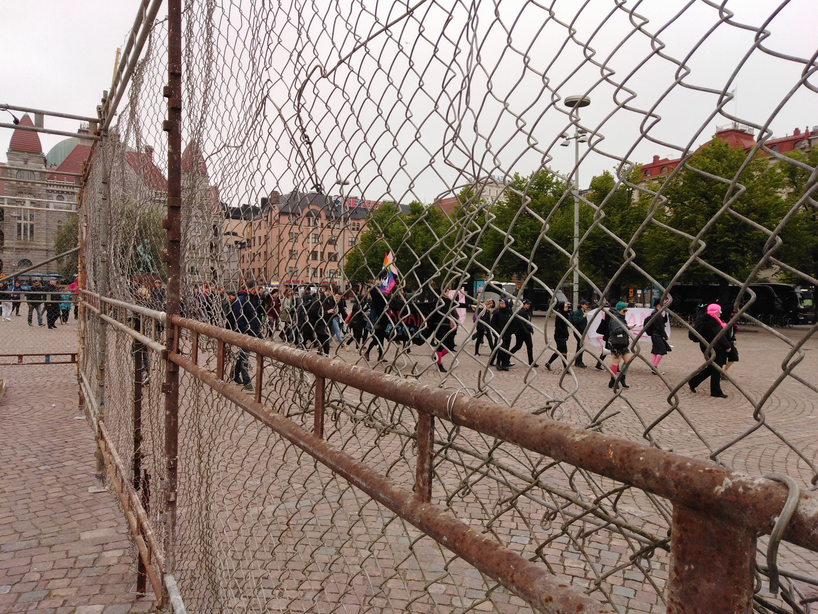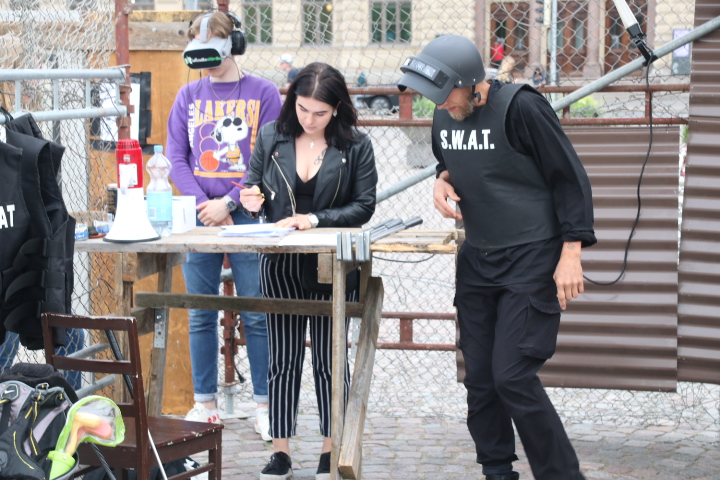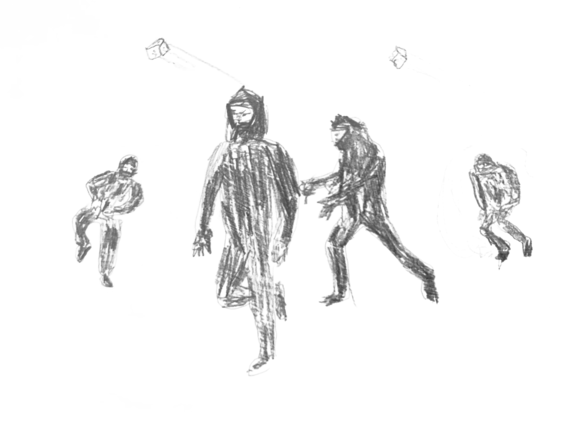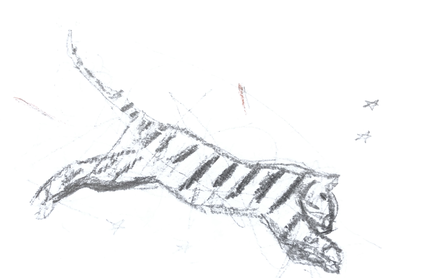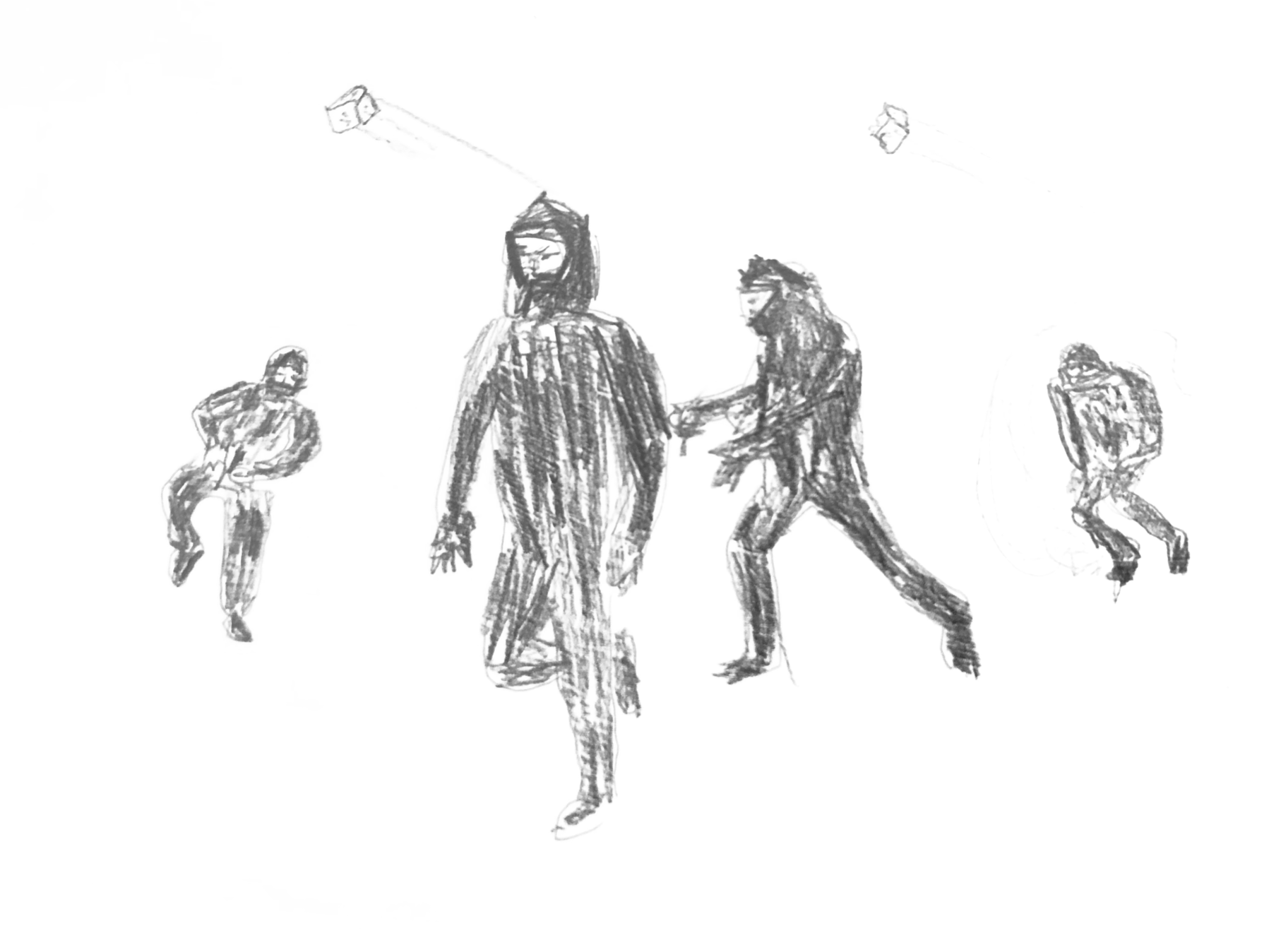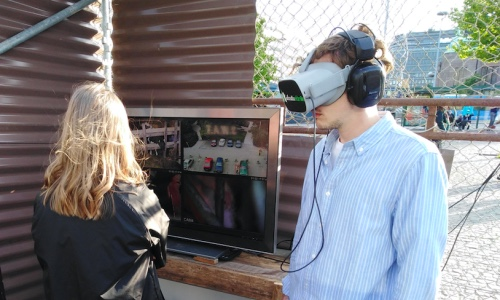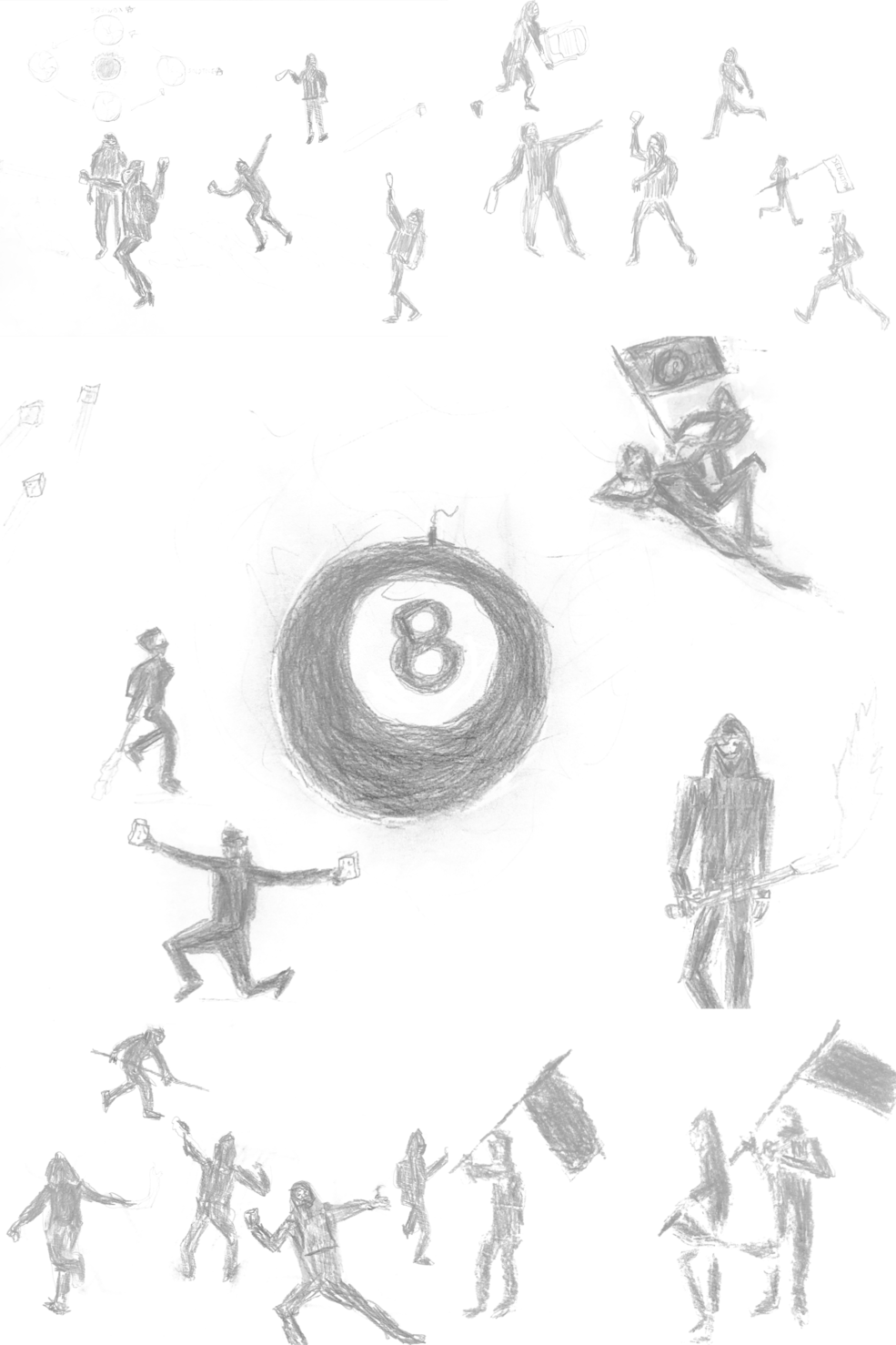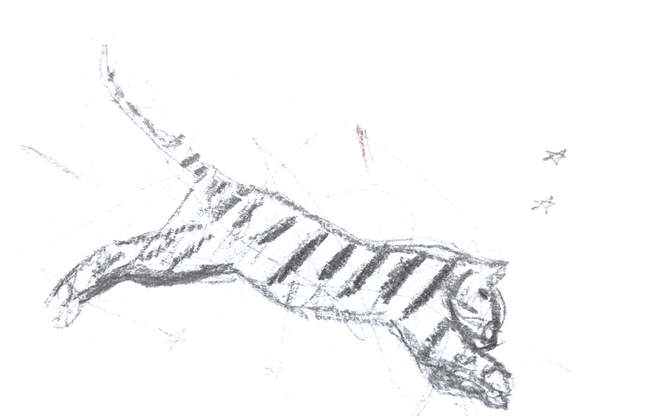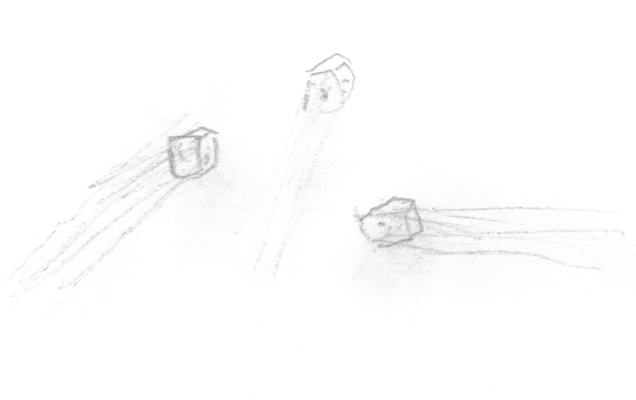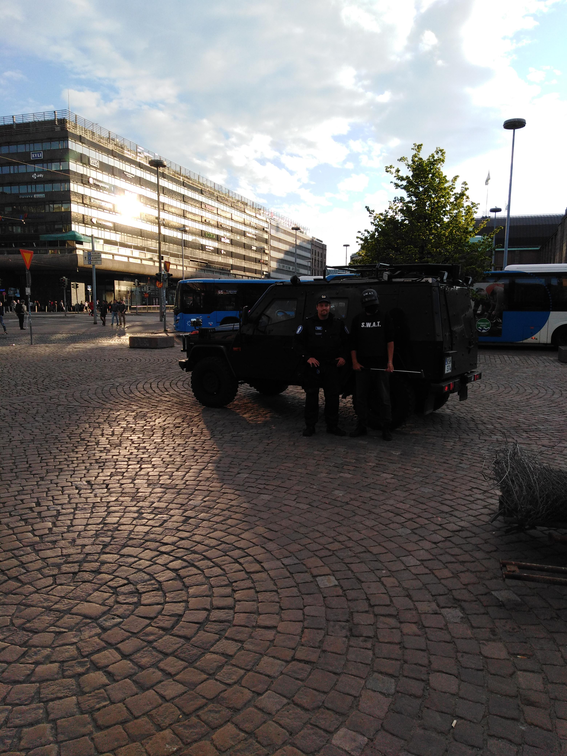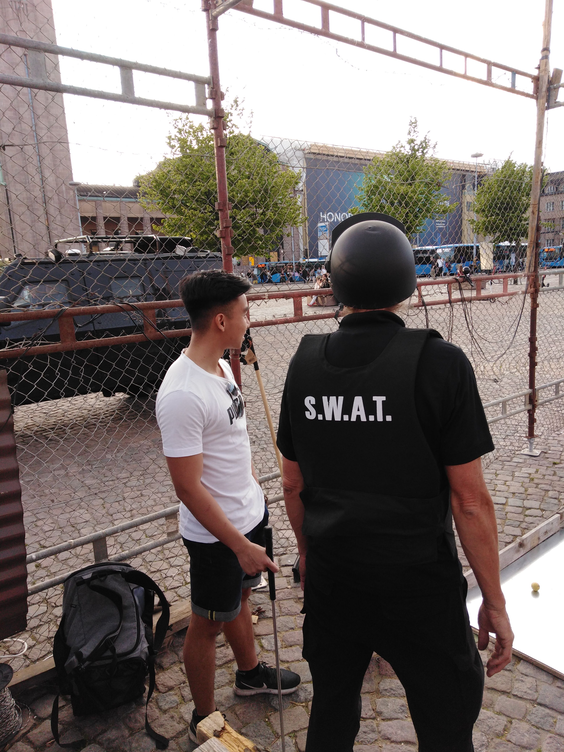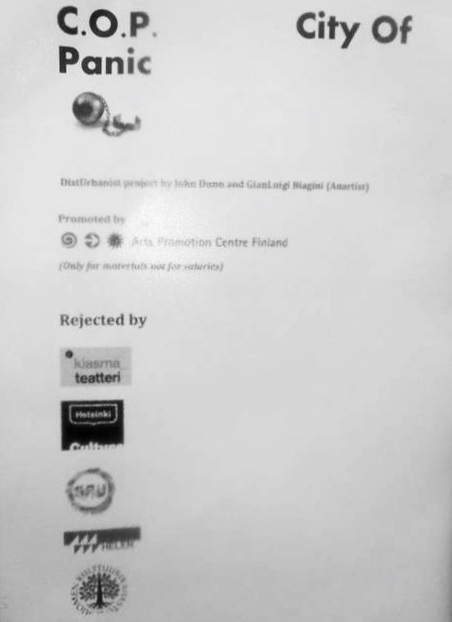INTRODUCTION
My practice arises from the subjective and contingent condition of unemployed migrant. This condition of cold isolation and social exclusion led me to produce a singular "existential ethic-aesthetic territory" (Guattari,1995) through a series of disruptions of the space-time organization of the hosting city, whose feature is a neo-corporative urban space that, in the name of a rigid consensus, annihilates that “heterogeneity and those creative becomings embedded in the multiplicity of subjectivities and configurations of space” mentioned by Doreen Massey (Massey, 2005). My disruptive interventions are embodied post-structuralist gestures of a heterogeneous difference, public speech-acts, “gestures that become event” (Buttler, 2017). These affirmative gestures of event-disruption and contestation, that I call “critical urban intervention”, take the form of performance-installations. They are gestures that repeat and differ" (Deleuze,1995) engendering an alternative existential refrain. They unfold their impersonal will of power, through a singular praxis of becoming, shaping an “existential territory” grounded in a “becoming-animal” and in the “bio-aesthetic belonging to a body, animality, Earth” (Grosz, 2020) This “bio-aesthetic grounding” is a "refrain of resistance" against the abstraction of urban space. I see my practice of urban interventions as the unfolding of a “bio-counter-territory”. Just as the birds define a "territorial milieu" with the refrain of their song, so the artist expresses those same intensities of the Earth with his own "expressive refrain". My practice sets the open Earth against the closed Globle. This is why my art practice, being a “becoming-animal” refrain, is counter-anthropocentric (it counteracts Anthropocene) and counter-capitalocentric (it counteracts Capitalocene as a radically intensified form of the Anthropocene). The capitalist design of space and its enforcement through laws, rules and police control tends to bend time to profile maximization efficiencies.The ideal of capitalism is a clock-city, a closed system, where time is money and people walk anonymous streets "as soulless zombies hyperstimulated by corporations vampires" (Giroux, 2011). To achieve this abstract "zombie-ecology", "space must be purified” (Massey, 2005) of its heterogeneous and dissonant lively potential; it must be reduced to dead habits by powers that are local and global to prevent a bottom-up politicization. As Massey (2005) has shown, the capitalist powers, which emanate from dominant global nodes, make use of material practices, but also of ideologies and representations that produce a standardized, measurable, technical, abstract, efficient, apolitical, supervised space, without surprises. This discipline of the space, carried out by private Corporations, Global Institutions and States, represses the heterogeneous subversive potential of difference which is expressed by minorities and anomalous individuals but also by non-human animals (industrialization of animal slaughter and removal from the sensory sphere). The "City of Panic" intervention challenges the top-down rationalization of space through the parody of mini-golf played in an interactive installation that resembles a concentration camp for humans and animals. The performance-installation gives a dissonant voice to passers-by who, by participating in minigolf, adhere to a political contestation of space, but also to the“agonizing scream of animals for slaughter that break the invisibility and inaudibility to which they have been ferociously relegated by the organization of capitalist space-time. The action gives a “poetical-political voice to the animal” (Manley, 2015). These interventions are Situationist “counter-Spectacular” (Debord, 2002) actions that activate “surprisingly new configurations of space” (Massey, 2005). In honor of Situationism, which intended to “transform the city into a playground” (Sadler, 1998), I have called these immanent disruptive events “play-ce”-utopias. The intervention "City of Panic", which is inspired to a Paul Virilio’s book (Virilio, 2008), highlights with a sense of tragedy and humor the surveillance, militarisation and imprisonment of space triggered by the spreading of panic in a closed City-Globe crossed by crisis, terror, tensions and conflicts. I performed about 40 interventions, which also concerns spatial issues of “gender” (Wilson, 1992) and “race” (Teverson and Upstone, 2011). However. when I address these “matters” I collaborate with another performer who is directly affected; otherwise for my sensitivity it would feel like an illegitimate exploitation of issues concerning specific minorities. See my website: https://gigibiagini.tumblr.com/
THEORY, PRAXIS AND METHODOLOGY IN MY RESEARCH-INTERVENTION. (SHORT SYNTHESIS)
"Practice has a logic which is not that of the logician. This has to be acknowledged in order to avoid asking of it more logic than it can give, thereby condemning oneself either to wring incoherence out of it or to thrust a forced coherence upon it. (Bourdieu 1990:80)"
If Bourdieu's sentence is true for practice in general, it is even truer for artistic practice that surges from an unconscious and an anarchist expressive bodily need. Artist practice is not a practice directed to a well-defined object of knowledge (as science) or functional goal, such as for example the practice of design or even the practice of politics which strongly inspires my artistic practice. For this reason even the practice of artistic research has the original sin of its "open object” of study that is less an object than a co-implicated event-process. The researcher that wants to describe the living phenomenology of his practice cannot reproduce a distanced “closed object” of study as in science but must be absorbed in the process-event in its immanence to extract the coherence that he can. Art research, that is in a chasm with the singular art practice “under” its study, is a co-creative event. If art is creation, art research is re-creation. My interventions are a practice of "becoming" (Deleuze and Guattari, 1987) where the practitioner encounters potentialities such as errors, accidents, contingencies, “synchronicities” (Jung, 1985), “derives” (Debord, 2022); and even the researcher, who is the same person as the artist, is implicated into this Peano-Monster event and experience. The non-linear creative process attracts and recombines heterogeneous parts that are not structured in an ordered signifier with a single A to B narrative and firm references. At the beginning I set up a concept and a design strategy but then the event-in-becoming acquires its own will to power. By this process of doing, handling and making, guided largely by intuition, sensitivity and contingency, the creative event of the New is possible; which upon its appearance will not be linearizable and therefore will generate a resistance: an ambiguity, an interpretative conflict, a heteronomic "differend" (Lyotard, 1988). Furthermore, in the creative process there is a continuous dynamic entanglement between the virtual and the actual as well as between the transcendent and the immanent, between events of different spatio-temporal scales including one in the other which resonate in a performative process unfolding. My interventions are based on a process dynamic and also the philosophy that underly is process-based; it is inspired by Nietzsche, Bergson, Heidegger, Deleuze, Whitehead, Prigogine and Mahayana Buddhism. Each of my intervention, and their co-unfolding research, is an interdisciplinary and affirmative uber-process event that leads to a gnosis similar to Nietzsche’s experience of the "will to power" (time as Kairos) and "eternal return" (time as Aion). This invisible mystic side of the experience, that can only be documented by writing, is also the most interesting to me; because it leaves in me a spark of eternity. My practice fights and unmakes spatialized "chronological time" (Chronos) which finds fulfilment in the clock: a time-quantifier of work and money (Marx, 2013). A materialist time that finds organization in the design of the capitalist space. My research concerns the embodied effects and affects of my intervention that unmakes the unity of capitalist space-time and unleashes decentered ripples of multiple space-times experiencing "a la derive" that does not form a closed whole. My embodied ontology of "difference" produces a phenomenology of "difference" that expresses an "auto-ethnography of difference" (with theoretical references “in flight”), which is in tension between "actual and virtual" (Deleuze and Guattari, 1987). Not only the intervention as process-artwork (and process-research) is a complex event but also it produces a "perturbation" of the usual "laminar" experience of urban space as a space where capitalist sense works through a specific organization of time and space; which constitutes what Mark Fisher defined the "Capitalist Realism" (Fisher, 2009). For these reasons (co-implicated process-event and perturbed situation) my phenomenology of the event is a non-linear and atmospheric bundle that my writing must unravel, suture, re-compose and unfold. Even the graphic design of this essay is a creative re-composition of the open heterogeneous experience with different planes and no arborescent hierarchy. The drawings are shadows of Revolt in the virtual background of my interventions. (They are also in tune with Situationism in provoking a slight blinding irritation for the reader.) The many photos and videos, so much as the elevated number of references “in flight”, wants to offer the reader the same “experience of excess" (Bataille,1985) that I undergo in a complex uber-event that overpasses itself in its becoming and cannot be easily framed but only grasped as "atmospheric phenomenon" in excess.
THE STYLE OF WRITING IS POLITICAL
My interventions produce a disturbed space and a time off the hinges (Deleuze, 2004). Post-structuralists would say that is a re-writing of the space which frees the experience of the semiotic chaos of the Chora; a concept which originates in Plato but which Derrida (1995), Kristeva (1984) and many others have deepened as subversive, confused and mystic experience which manifests itself with unexpected cata-comic events (Bergson, 2014; Deleuze and Guattari , 1987; Land, 2018) or with a-causal “synchronicity” (Jung, 1985), with disclosures of the “open” (Heidegger, 2006), with a "time-image" (Deleuze, 2013). Creative writing as an art in itself becomes necessary to "move in a zigzag tension" (Deleuze, 2022) on the edge of the "thousand plateaus" " a la derive" of the artistic experience of the “Khora”: heterogeneous planes that must be recomposed with a creative act of writing "in flight”. This pragmatic eclecticism is in philosophers of knowledge such as Kuhn (1962) and Feyarabend (1975) and my research can be seen as an an auto-ethnographic “edgework” (Lying, 1990) of a “limit-experience” (Bataille, 1985). I realize that reviewers sometimes are art-object oriented and seem to be unaware of the problem of describing a molecular and complex process-event, such as a radical urban intervention, and setting it within a theoretical frame without creating an impasse to the flow. A possible complaint about my style of writing is that it can look aggressive. This happens because my writing springs by a rebellion of my flesh to a capitalist normalising “inCorporation”. It follows the style and aesthetic of the intervention; which is also an act of social laceration, disruption and derangement of the social body to show a felt injustice. An objectively detached style would betray the singularity of the practice as felt experience for a fiction of "disembodied knowledge" (Damasio, 2005). An authentic ”incarnation" (Henri, 2015) through “pathos” is relevant in art. Writing cannot betray this pathos. Research cannot be a neutralization of the subversive “aesthesis” unleashed by an "art that hurts”. Otherwise art research becomes a reactionary box for "recuperation" and "normalization" of what the intervention “politically discloses to be seen and heard beyond the institutional partition of the sensible” (Rancière, 2010). A neutral style in research and writing is not “neutral” but also is political because it confirms and legitimates the neutrality of the status quo. In order to be politically active you need an engaged subjectivity with a flesh that feels the “pain” and the "wrong". Furthermore, pathos and affects generate contagious; they are political because they can aggregate and spread movements. The subjective “style" of writing is political as Deleuze and Guattari (1986) and Rancière (2000) put it. It singularises the event that is an artistic, political and written singularity. My style is not a pose but a matter that concerns me and discloses an expressive world of flesh. My blood is the ink, my skin is my paper, my wound is the voice that wants to be heard.
THE CONTESTED CONTEXT :
THE SOCIETY OF CONTROL AND THE NTER-INSTITUTIONAL POWER-NETWORK
The intervention City of Panic, has been realized in Rautatientori (Train Station Square, Helsinki, Finland) by John Dunn and Gian Luigi Biagini (the Anartist). The square is one of the most central in Helsinki and the event took place from 4th-18 June 2019. We had asked the city for at least 3 weeks, considering the time needed to build the installation and also the investment in terms of time, money, and work required for the project, but they refused to give us more than two weeks. At the beginning the idea was to participate in the URB 2019: an urban art festival organized every year by the museum of contemporary art –Kiasma. Our idea is to collaborate with museums and academic institutions because it is absurd to pay a gallery when the purpose of our art is not selling but to produce a perceptual critical wound in the everyday capitalist space. However, after 6 months of negotiations, they rejected the idea to include our project, even though we already had a grant. Our purpose was to be integrated in a museum festival and to get at least communication support directed at the art world. Even if we are heterogeneous with the art world we are interested in a radical contagious in it; as much as with art research academies and art museums. Our purpose is to move as “virus” (Deleuze and Guattari, 1987) among different institutional bodies that could host us in an edgy reciprocal tension. But as it happened, Kiasma progressively made a wall against our proposal. They turned our voice off by turning off communication. Why? Because as an institution they prefer not to be involved in projects on the “edge” that can provoke a slide into an unknown territory: a Situationist avalanche. This is what I could perceive behind their talking of dangers and insurances. Institutions do not want to risk provoking a disorder because they can be criticised by the network of power they belong to. They must control the effects of an artwork because, as institutions, they are part of the synchronised system of inter-modulated control our intervention goes to provoke and possibly shake. Power is now organised in a dynamic modulating network as shown by Deleuze in the “Society of Control” (1992). For museums and other institutions this attitude of control is legitimated by "social responsibility"; but for the point of view of the Anartist (Anarchist Artist) practice it is the logic of an "apparatus" that responds to the precise inter-institutional politics of “what can be seen, heard, felt and thought in the public space” (Rancière, 2010). In their managerial political perspective urban space is a trendy “cool thing” to attract tourists and capitals for the financial markets. An ordered society under control has become an asset for safe financial investments. Every country wants a triple A from global rate agencies that are global institutions of surveillance. Social security and retirement pensions of the countries depend on how a city or a State sells itself in the financial market. Financial market has become a global compulsive superego for each country and city. In order to fulfil this new “discipline of financial-markets' ' (Lazzarato, 2012) the integrated hierarchies of control want to build a smart image of a country's community to compete in the world. They follow a “City-Brand” guideline and operate in a EU "ordoliberal” (Re, 2018) framework that is different from classic neo-liberal Austrian (Von Hayek, 1973) and Chicago (Friedman,1962) free-market schools. In this "ordoliberal” project, the State collaborates with Corporations to form a society-consensus that promotes smart start-ups and innovation. Art itself must be coded as innovation for a “smart city” for a new “creative class” (Florida, 2002) in a capitalist paradigm. The space for art is subsumed by design or occupied by ambitious functionaries of culture and art who “police” the socio-economic order as if they had been educated in a business school. These functionaries consider art as a profession and a career based on consensus when art should be “anachronistic”, “asocial” and challenging the present and the actual status quo. If museums and the art world are lost to the cause of rebel bodies, art research, because it has also a critical agenda of changing, should host “the heterogeneous” to compose an edge in becoming. In a context of society of control the “re-appropriation of urban space” (Lefebvre,1992) becomes an urgent need to keep “art” and “politics” alive! But also “art research” and “art education”! Our practice of interventions tries to find an impossible “edge” for the “outside” (Deleuze and Guattari, 1987). Our actions inject new life, critical imagination and surprising plasticity in the urban space to escape the monotony and control of its bureaucratic management. We make what is repressed to appear as a counter -Spectacle (Debord, 2002). Inter-passive consumers of the digit-urban space entertainment are counter-activated as citizens of a Polis open to the deranging Khora of the intervention. We should have the support of “art research” institutions in our striving and also “art research” should accept a critique of its own practices when they become too rigid paternalistic. “Art research” should be open to a certain degree of anti-institutional, non-institutional and post-institutional practice in its everyday practice. “Art research” itself should become a living example of an “alternative” to Capitalism by not reproducing the attitudes of the” Society of Control”. Otherwise it becomes a sub-system of the apparatus of control that shows itself with a paternalistic face. Today if you want to make public art you should be decorative of the ideology. The “good-hearted” neo-paternalist face allows the institutions to appear with a humanist centrist legitimisation and to operate with an efficient invisible network of soft-repression that encircles everywhere the society. This soft Neo-liberal Neo-paternalism, which is a consequence of the State-Corporate “ordoliberalism” is circulated as an ideology of “social responsibility”. The legitimisation of this apparatus of control consists in its ability of pushing back the repressed mounting wave of dark passion of a far-right that wants to abolish not only the elite but also minorities and migrants. However, this management of fear produces a sick feed-back because the more passions are repressed and the more they grow in a perverted way. This is shown in every new election! However corporations’ strategy is flexible, they are ready to “inCorporate” far right nationalism if this strategy guarantees their profits. This also makes sense in an optic of regional de-globalization and re-shoring in a new virtual Cold War. Because of this growing fear of far-right passion, free-thinking and critical ideas cannot appear and affect the urban space anymore. For the establishment is a good opportunity to close the expression of the non-normative "political" in the “clean" (Ross, 1996) and ordered centrist perspective of “communicative rationality” (Habermas, 1985). The ideology of “communicative rationality” is the standard of the trans-institutional network that cooperates on “common values". The institutional synergy recognises only the identity of an ideal community open to a domesticated “diversity” but not “Difference” in itself. "Difference" disturbs what is “common” by contesting its centralised structure of mediation and signification. Private and public foundations love granting projects that become part of a common centralised strategy for a country-image brand (but are ready to jump into a national or regional nordic perspective; as I have understood with a recent shocking experience with a foundation). “Difference”, that is a free sensing-thinking, is a luxury that a competitive society cannot afford anymore. It is a waste economy that cannot be recycled into a virtuous plan of “ordoliberal” competition. Far right instead can be recycled into a virtuous national or regional capitalism, it is not a wasted economy as it could appear. And even global finance can always speculate on crises, fears and new scenarios of global order. My interventions are not so much a danger for public order because they cannot ignite an urban revolt but they are a problem for the urban brand image and a waste of focus in “control” (Deleuze, 1992). They should not be promoted for the sake of efficiency, public health and public and private finance. In this way a control through institutional culture is created that eliminates every critical "line of flight" that could break the centralised “consensus” of the “Brand”. It’s immoral to show in public the shadow of Capitalism that wants us to be consumers but not active citizens, thinkers and artists. To paraphrase Hanna Arendt (Arendt, 1970) the consumer is now a citizen retired in the private “Oikos” even when he or she occupies the public space (see the bombarding of electronic mobile gadgets always plugged in the ears and eyes) and, reversely, the urban space as Polis is occupied by the Spectacle of private “Corporations” as subjects of the “Oikos” (noisy mega-screen with advertising but also subtle influence in education, art and culture). It is a privatisation of public space and a privatisation of life. To put it in terms of Marcuse (Marcuse, 2002) leisure time becomes a materialist time of work for the reproduction of Capitalism. Desire is caught in a “productive consumption” (Bataille, 1988) and turned into a capitalist cycle of work, it is not wasted for an “outside”. It is an imperative ethics for art and art research to re-appropriate this alienated space where we live. It is the vital mystic law of metamorphosis that asks us to produce a crack in this monolithic corpse for zombie-routines.
THE OBJECT OF CONTENDING
The process of production of my “interventions” is not a precise abstract project that is implemented from A to B, but a contingent performance-process that, at the end, shapes “something” that has a consistent concept and aesthetic. The resulting installation-performance is shaped by a field of forces, opportunities and constraints in play. I must stimulate, follow and adjust, in a continuity of sensations and pragmatic logic, the effect and counter-effect of a semi-impersonal will that at the end can reveal deep archetypes. There is something rational but also magic in the coming in the world of this “something”. It seems that an entity of the beyond, with an electromagnetic soul and a will, is actualised from a living continuum that fades in the unknown. In this process it is also difficult to separate the external material world from the internal world of the creative producer that is a Dreamworld affected by the possible, the virtual, the imaginative, the kinaesthetic, the erotic, the electromagnetic. This experience of production is consistent with the processes and emerging attractors described by Prigogine’s “Chaos” (Prigogine, 1984), by Bateson’s “Emergent Mind” (Bateson, 1972), by Whitehead’s “Superject” (Deleuze, 1988), and by Deleuze and Guattari’s “desiring production as becoming” (Deleuze and Guattari, 1987).
At the end of a creative process of production and construction, full of contingencies, the incarnation of this “thing”, C.O.P. City of Panic, was 25 meters long and about 5 meters tall. It looked like a long linear cage, with many surveillance cameras located throughout it, 5 meters high metallic fences, and barbed wire on the top. This rusty metallic “cage” contained one wavy 21 meter long “mini-golf” hole made from a 1.25 meter wide strip of new shiny tin with a hole at one end. Because the emerging “thing” was an alien “meshwork” (Delanda, 2005) of many superposed and intertwined narratives I will take in exam only 2 of them that I can define “critical” and “mystic”. Furthermore the “critical” narrative bifurcates in “local” and “global” but also mixes them into a differential “glocal” play-ground of resonating specters. In Difference the mystic permeates the critical in a continuum “rhizome” (Deleuze and Guattari, 1987); as in a “ghost dance”(McMullen, 1983) The concepts of “critical play-ground” or “play-ce utopia” are consistent with all the intertwined narratives of the C.O.P. “installation-performance”. We will see how they are operatively applied in my article.
LOCAL NARRATIVE. C.O.P.City Of Panic has a satirical function. “Mini-golf” is a typical pastime of the petit bourgeois in a thoroughly standardized and disciplined modern society. It’s a surrogate for the masses who can’t afford the elite’s model. Rich business managers love travelling around the world playing golf. It’s a form of elite belonging to a status symbol that mixes the play with the business. The concentration required in golf is the concentration praised in business. “Hitting a good shot in a round of golf is a great business card!”. Instead the alienated masses play mini-golf as a means of distraction from the pressure of the family and other issues in a “restricted economy” (Bataille, 1988). “If the children play, they don't create problems and I can finally relax.” Nevertheless, even if messed up by the indiscipline of children, the structure of the mini-golf play is the same as golf: “be focused and concentrated on your goal”. The same social injunction to be focused on a narrow task that in mini-golf is only “cheaper” and more “profane” than the international tourney of the Corporate's bosses. Our satirical installation-performance has intensified the gradient pitch of discipline, surveillance and control already performed by the institutionalised play of mini-golf; by transforming it into a surveilled and fenced concentration camp for the masses. Mini-golf is a place of concentration of the masses that also simulates a hierarchical dependence from the values of an elite’s model. It is social training to the norms of consensus. This is how an "ideology apparatus" is formed according to Althusser (1970). For Althusser is not the belief that creates an ideology but the practice. This is why for the Anartist it is important to show, criticize, reverse, make fun and disrupt these practices (with their stiff ideology, passive subjects and imagination). The linearity of our mini-golf, a regular strip of metal of 25 meters, wanted to stress the boring monotony of playing inside a linear cage with only one hole (the only option for the top-down organised masses). Of course this is a hyperbole. As the Situationist Baudrillard (2001) used to say: “in order to see the true nature of a social phenomenon you must carry it to the extreme”. This caged linearity, this boring captivated play was strategically set in the middle of a central square of Helsinki to result as a critical metaphor of the boring entertainment provided for the masses in their subjugated leisure time. It was the metaphor of low intensity entertainment that ties the masses to regular flow of desire, action and organised social work that can be easily managed from the top of automated and computer-aided private and public bureaucracies. In French the computer is “ordinateur” to underline this bureaucratic function. In the techno-surveilled ordoliberal city there is no separation between time of work and leisure time, discipline and play, art and profane entertainment-control. All opposites, including private and public, cooperate in an integrated synergy with no exit like the 01 of a modulating digital cage (this modulation is represented by the waves of the mini-golf-course). Our caged mini-golf, City of Panic, showed in public the subjugated position of the blind masses inside the power-relation defined by urban space as a systematic space of ordoliberal institutionalisation of the processes of production and reproduction (consumption, formation, architecture of space-time, etc.). Ordoliberal ideology (Re, 2018) appears as a progressive State-centred economy but refers to the imperative of shaping “business attitude”, which is not considered natural as in Austrian and Chicago's Neo-liberal School. The ordoliberal State, like the old socialist one, intervenes from cradle to grave and forms all life in a “biopolitical” action (Foucault, 1979). The subjects shaped in this system are not even aware of it, they just play “mini-golf” in their leisure time and focus on their task. They are concentrated and focused on the hole but distracted from the whole; but in their narrow perspective of the hole their task to reproduce the whole is well accomplished. Reproduction becomes a complement of production. It is the “Ideology of State Apparatus” described by Althusser (Althusser, 1970). The only way to escape to this mini-golf cage, that is also a miniaturisation of the being in a family-state-business “ordoliberal mould”, is to perform along the “edges” of this suffocating structure by interpreting “masks of disorder” with public performances. The “masked edge" of the performance provides protection from the Police, even if it is not a safe protection at all as I have shown in other articles. You risk being fined, smashed, handcuffed, interrogated, sprayed but you are not naked as if acting without a mask; you can play on the ambiguity of a performance and negotiate your position with Police. These interventions open up the cage to the non-identical, non-linear, non-relational and the unknown; they provide a “deterritorialization” (Deleuze and Guattari, 1987) that dissolves the signified perimeter of the cage to provide “lines of flight” (Deleuze and Guattari, 1987). The limits of escape “becomes-imperceptible” (Deleuze and Guattari, 1987), a negotiating variation. It is absolutely a need of health doing these interventions to escape the incorporation in a shaping bureaucracy that lives each reform with the zeal of the protestant reformer. Efficiency, austerity, martyrium of the “flesh” for the abstract norms and business competition are enforced by a continuous institutional reform, and updating to new technology to reach the ordoliberal virtues of a modern society of market driven by the procedures of State. Everything is anachronistic and not convergent must be eliminated. Me and John Dunn were wearing a SWAT uniform and patrolling the perimeter of the “mini-golf cage” accompyning the passers-by who wanted to enter the cage and playing golf. The passers-by could participate by signing a bureaucratic paper at the beginning. The signing of the paper was both a playful performance and a prescription of the city’s institutions to discharge us from any accusation should the participants hurt themselves. Most of the participants who entered the cage to play knew to participate in a “critical play-ground” and that their gesture was political. A few were mainly attracted by the idea to play something strange and for free or they were puzzled and asking the meaning but the majority were aware of the political value of their action. Our performance-installation provided what Deleuze and Guattari called a “disjunctive conjunction” (Deleuze and Guattari, 1987) in the organised metric of space-time. Indeed, our installation allowed a participating critical performance that separated a new critical temporary community-space by the ordinary massification that moves along the trans-institutional guidelines as a mass of solitary atoms or nuclear families with an already defined “partition of the sensuous” (Rancière, 2010) and the “symbolic” (Lacan, 2013). It was also like a “switch” (Land, 2011) that inverted the flow of desires against the system: at least in a critical, playful and parodic way. A dystopia that was also a “heterotopia” (Foucault, 1984) because it acted as an opening in the everyday “Truman Show”. The reaction of the passers-by was largely positive but we had also a case where we were attacked by a good-looking white suprematist (an anomaly) that started to complain of the “animal scream” coming from the loud-speakers; then he started offending because we were foreigners; then he started threatening physical violence; and then he called the police as a “good citizen”. We enjoyed playing with this situation as if this guy was part of the “critical playground” we had been set up as an inducer of Difference. The “playground” does not recognise a full identity to its surrounding of objects, buildings and people that become part-objects and part-subjects of a dynamic assemblage that has never a unity of signification. This turning signifier generates comic-effects. Every component is a performative appearance to play with; also the enraged white suprematist enters into a spinning groundless ground where the signifier is bifurcated, subverted and reverted. The surrounding space spins around in a difference of shifts as an exhilarating “roulette” Casino. The playground is grounded only in its own spiralling. It is an anomalous “haecceity” (Deleuze and Guattari, 1987) that cannot be counted in the metric of a striated space of a system of signification and by the power that institutes the system. The play plays itself. It is “crowned anarchy” (Deleuze, 1995); a field of “active forces” (Nietzsche, 1994) that by a transpersonal play of changing masks turns identity-subjects and identity-objects into an assemblage of shifting “simulacra” (Deleuze, 1995) of different intensity and vector. Everything converges and diverges at the same time in a ghost dance, or turns its face or jumps from one side to the other breaking the dialectical structure of identity-oppositions. The intervention looks like the magnetic trigger-inducer of a “critical playground”. The animal scream of the loudspeakers that engendered the enraged reaction of the suprematist guy was connected to a video and a 3D experience of a butcher industry. We wanted to disturb the neutral modern routine of urban space with something hidden and removed from our ordinary gaze. This idea was inspired by Marx (Harvey, 2016) and Bataille (Hollier, 1989) account of the removal of the batcher market from the centre of Paris after Haussmann’s renovation of the city. The renovation was a typical reactionary reform of the leading technocracy that has become a prototype for the action of modern planning bureaucracy. Not only the narrow streets of Paris were enlarged to prevent barricades and to allow access to horse-mounted police but the butcher of animals was transferred to the periphery of the city; far from the sanitised gaze of the urban citizens. According to Bataille this reorganization marks a separation of death and life, clean and dirty, profane and sacred, human and animal that is typical of the modern city; which is founded on the profane and the removal of the sacred. The show of blood of the butcher was a remnant of an ancient ritual of sacrifice that happened in the centre of the ancient city and established a deep bond through humans, animals and gods. The foundation itself was marked by a sacrifice and the construction of a temple” (Eliade, 1963) that established a sacred space proceeding from the center. Now with the expansion of modernity the butchering of animals is removed in an anonymous faraway industrial complex where animals are butchered in industrial quantities by machines. The sacred bond has been severed so that the animal pieces of meat are shown in shining and cleaned packs in “cool” supermarkets as “commodities” without any reference to its sacrificial origin. There is no respect for the animal that has offered its life for our life and not even an identification in its suffering. Death is removed by the City so much as the circle of life between animal, human, gods and its void is filled with cold productive consumption. The productive consumption of this “restricted economy” (Bataille, 1988) is not really “jouissance” or “surplus-enjoyment” (Lacan, 2006) that celebrates the inevitable “consumption” of life (Death) with a Dionysian excess but a function of “reproductive work”. In this urban space there is only cheap profane “pleasure” like playing “mini-golf”. The urban space is part of a conservation plan based on “vitalpolitik” (Re,2018) and public health. The expulsion of the sacrifice from the city is profane normalisation of the masses. The masses are sedated by an an austere "decorative" “discipline” (Foucault, 1995), “repressive desublimation” (Marcuse,2002), technological “control” (Deleuze,1992 ) or “easy pleasures without the pain of transgression” (Lacan, 2006). We wanted to bring back the horror of this removal of the Dionysian from urban space with a 3D and sound presence; in order to stimulate a sensorial excess: a return of the repressed that could open this mechanism of “mystification” and "erasure of the flesh and the meat". I like the subversive use that Bataille does of Marx: the idea of “mystification” tied to the removal of the sacred. Indeed, often “mystification” and “Difference” are seen as opposite. For the theory of Difference only a surface of dynamic simulacra exists that does not occult any original essence; but for me “Difference” is the sacred spinning experience that is occulted by identity that is the “profane” order. I think we should read Bataille’s “sacred” in this way, as a Dionysian Difference that appears in a public space; the other face of an Apollonian identity-management illuminated by the agencies of control of space-time. The “playground” experience is a sacred dance of dysfunctional and disfigurative presences of an occulted world that lay in the underground potentiality of the modern metropolis. While the City usually belongs to Hera and Athena the intervention opens a path for the underworld of Persephone. Indeed it must pierce ("persephonner" in French) the identity consensus of systematic power-rationality. The modern City is crossed by chthonic forces in tension with the Apollonian administrative management and its profane organisation. An uncoded active brownian motus of forces is ready to emerge from the linear organization of the space if we want to give a radical interpretation to De Certau; a time-image open-whole is ready to breakthrough from an action-image closed-set if we want to give a radical interpretation to Deleuze. Our interventions tap in these occult shadow-forces. The intervention intervenes with a breakthrough that unleashes these currents of Difference to open a sacred “play-ce utopia” that is the shadow-play of a “distopia”; a spinning “play-ce” outside an identified space and time. In Difference the mystic immanently spins with the critical. They also laugh at each other. The telluric force of Difference is the pressure of a laughter that dissolves the austerity of the fortified order of representation. The “glacier of the city-bunker” (Virilio, 2006) is taken by siege from inside through an “imperceptible” (Deleuze and Guattari, 1987) “intruder-hacker with a mask” (Land,2011) that makes the space laughing.
GLOBAL NARRATIVE.The fenced cage of the mini-golf did not refer only to the local space striated by bureaucracy but also to a global architecture of repression, surveillance, segregation and securitisation that is the prevailing Zeitgeist in global space. For example the undulated shining tin of the mini-golf was reflecting the sky and was clearly resonating with the small waves of the Mediterranean sea. It was echoing with Libya’s shore and the concentration camps in which African migrants are secluded with the “placet” of the EU and its Court of Human Rights. This was an apparition due to Difference; I did not anticipate this Libya-effect. Heidegger, a shaman of Difference, says that the work of art emerges in a “fourfolds play where Sky, Earth, Mortals and Gods reflect each others” (Mitchel, 2015). I like to think that the Libya-effect of the caged mini-golf was due to this mystic play. Nevertheless, the “spectral hauntology" (Derrida, 1993) of the cage architecture was resonating even with spectres such as Guantanamo Bay, Palestine's check-points, Mexican Wall and an entire architecture of violence and seclusion. “Hauntology” is also part of the echoing aura of the playground of difference. The “playground” is haunted by a Chora of “gheist multiplicity”. Our installation-performance, the caged mini-golf, was titled “City of Panic” and was inspired by Paul Virilio’s essay with the same title. Paul Virilio writes that in globalisation there is no more a horizon outside the Globe and all the tension is imploded/exploded inside the Globe that becomes like a huge “City of Panic” (Virilio, 2007). The result is that in this implosive/explosive tension of accelerated forces in a closed system the centres of the Global City cannot hold the siege and push away their peripheries. Even if the centres try to manage the tension with architectures of violence, surveillance and separation the terror finds the way to cross the barriers and it passes through the centres. It is a contradiction of globalisation. This panic of terrorism carries to the militarization of the civilised urban space of the cities. Not only surveillance cameras everywhere, security-passwords of access, gated community and tracking of all digital flows as in the “Society of Control” described by Deleuze, but also a military occupation of the urban space. Only in this way can we explain the apparition of a super-armored black jeep of the local anti-terrorist SWAT police that started to surround our “thing” everyday; as if our performance-installation was an enigmatic source of terror that deserved such a militarised control. I can explain this paradoxical apparition only with the play of Difference that we had triggered. The black armored Jeep was aesthetically and conceptually a perfect complement of our performance-installation. It not only marked an opposition but also showed a consistent extension of our installation. We could hit them by hitting golf balls passing through the holes of the fencing net. With their presence they were performing for us an adversary target but also offering a complementary relation and making our artwork more monumental; a counter-monument to the “City of Panic”. For the absurd logic of our “playground” they were not opposing or controlling us but establishing a bridge to play with. We were the terrorists that deserved surveillance but also their SWAT squad double. We were also surveilling people playing mini-golf in the cage, they were helping our job as colleagues. This is a strange but humorous accursion due to the spinning currents of magnetism that we have liberated in the space-time of the square. Our performance-installation has caused the symbolic order of the square to explode, opening many new semiotic paths and vectors of energy. Our installation-performances are triggers to activate under-forces that emerge on the surface and enter in play. They are creative in themselves; an effect of the chaotic intensities subtracted to the axiomatic extension of the State’s control. As it has been underlined by Virilio the pressure of these forces is growing in the Global City because they are more and more concentrated; they are the rest that cannot be systematised in the technocratic global order of a closed system. The power of technology and speed is growing but the Global City is closed in itself and this excess is implosive and explosive. This produces a tension on the edge of schizophrenia and paranoia. The urban area is crossed by telluric forces of tension. These effects which should have tragic resonances, even apocalyptic ones, are also subversively “cata-comic” (Land, 2011). Difference is like the laughter of the joker. Joker does not laugh because he is happy but because it is a convulsive play of the nervous system that the subjective conscience cannot repress and control. The conscience in our case is the one of the State with its systematising panoptic gaze over the City but the forces impinges in the nervous system of this “City of Panic”. It’s nothing strange laughing through a “Panic Attack”.
GLOCAL NARRATIVE. Europe is now like a fortress with cages of migrants to its borders in Greece, Turkey, Libya, Hungary, Italy, Spain but also more “civilised” countries (which are far from the South of the World) such as Finland have their detention centres. Far right is gaining consensus in all Europe, including nordic countries, exacerbating the already rigid control on migrants promoted by the “ordoliberal” left and right. They both are centrist powers, moderately pro-migrant, which operate through a soft but pervasive discipline, which consists in channeling, forming, segregating, integrating, excluding and marginalising the “reserve army” (Marx, 2013) of global “human resources”. The institutions reach this goal by the law and a more subtle “management” that operates through the barriers of language, the agencies of work, the grant decisions, the intimidation of the normative tone of voice allowed in public life. This “governmentally” (Foucault, 2005), is based on silence and aggressive passiveness; the tone of voice of the public sphere must be low, detached, simple, linear. In this way the passivation of consensus is guaranteed. The intervention must not be opposed or this event could generate more noise. It is enough to encircle the installation with police 24 h in a way that the event remains in the safe contours of the "entertainment". The tacit silence of media, art and cultural institutions do the rest of the Police work. In this way no bottom-up event can enter into a public democratic debate. Everything works as usual. Migrants are fully assimilated as human resources in a Corporate culture without any possibility to carry out their difference. More the migrant searches to become visible and heard, the more isolated and silenced. It is a spiral of passive aggressive discipline without exit that operates to remove the intensity of the flesh for a full paralysis of the inter-institutional face. There is an “invisible violence” (Zizek, 2007) that operates to separate the rational mind from the "rebel body". Art Research should counter-effect this “disembodiment” because art without flesh is a failure! What is the goal of Art Education if not thinking through the senses? But the situation is getting worse and worse for the migrants. The regional re-shoring of capitalism risks producing an escalating economy of war supported by advanced technologies promoted by militarised finance. Technology, speed, finance and war integrate perfectly into the management of fear by discipline. After having integrated “leisure time” in “work time”, capitalism has now integrated “peace time” in “war time”. As Virilio puts it in “Pure War” (Virilio, 1997) there is no more difference between peace and war because the “integral incident” of “total war” is a permanent ultimatum. This de-globalization of the capitalist chains of value, due to a new Cold War, risks to make even more restrictive and normative the logic of integration for the foreigner. A logic that already now is not multicultural but is a logic of "assimilation". In Helsinki you cannot work if you do not speak and write Finnish; even if you come from a EU country and you have a PhD assigned by a prestigious Finnish University. But if you want to work as “cleaner” of the homes of the “full A-citizens” or “deliver” them a pizza you are welcome in the army of labour-reserve of capitalism whatever language you speak. And this double-slit machine of segregation channelling through language is a shared idea by governments of right and left that is not contested by anybody. Intellectual foreigners feel badly about this problem but cannot express it openly because they fear some kind of retaliation by the tight shared consensus. Finland, more than other countries which openly show brutal repression, provides “confessional institutions” (Foucault, 1978) to solve technocratically the problem of foreigners. The whole institutionalisation of the foreigner is part of an invisible soft management of exclusion and privileges that integrates a logic of hard exclusion at the borders. You feel the compulsive injunction of the institutions to learn Finnish if you want to find a job and you know that you need a very high level if you want to exercise an intellectual profession. In order to participate in the selection of public employment in the sector of art and culture you are supposed to know Finnish and Swedish at a university level. This looks like a hopeless task and a non-sense waste of energy, time and lives that triggers a refusal to submit to assimilation; but there are no other options than just living with the money of Kela and rarely some grant - and being secluded in your apartment because you cannot spend money once you have paid your part of the family rent. Then, because you are isolated you cannot improve too much in your Finnish even if you wish. You are fucked up and start doing public interventions to denounce this situation but this provocation engenders only fear and judgement in the functionaries of the institutions. The system pushes you to be dysfunctional if you want to survive to isolation but then being dysfunctional becomes a spiral-cage. Your public reputation is ruined and nobody will give you a job anymore; and even the foundations will make you a problem in giving you a grant. You become like an "uncountable anomaly" in a closed “set”, as Badiou would put it (Badiou, 1988). According to the optimistic view of the French philosopher you become a "subject of truth that carries within the promise of the infinite", but then it becomes difficult to break-through this cage surrounded by Police and conformist judgement. The mantra of Mahayana Buddhism sustains my practice of justice and helps me to recharge creative energy to stick to the “promise”. Nevertheless it is not easy to escape a “cage” of invisible barbed wire that is global and local. You are not even considered an individual but “bare life” (Agamben, 1998) of a “zoe-politics” that wants to strip off your individuality to assimilate you as secluded and silenced marginal; you become a “social number” to manage through computers, data, procedures, norms and veiled threats that are reiterated every day and in every place. I should "stay in the place assigned to me" (Ranciere, 2010) by the bureaucratic machine as a “dividual number in a data-bank” (Deleuze, 1990). Because “Das Man” (Heidegger, 1996) does not want a contagious difference that is added but a cold organized diversity that is assimilated in language and norms or else you are humiliated and secluded in a "cage". You are secluded at home while your PhD, after years of unemployment, does not worth anything anymore. The only alternative could be the "dishwasher" (but they do not like to give this kind of job to a highly cultured mature person because they feel "guilty". They smell you do not fit there and they do not help you.) This is basically why I felt the need to show “this cage” in a public space. The public space has become a mirror of my "personal drama" and of the collective unconscious. But this scandal has been contained, encircled, moderated, sanitised by the virtue of the silence and the “social responsibility”, which now is a mission of every big and respected Corporation and Institution. The purpose of my interventions is not to unleash an actual riot but a "virtual riot" that makes people think through a difference (an “atmospheric change” (Borch, 2014) of the public space); it is a molecular practice of critical theory in performance. If we are encircled by Police it is ok because Police is incorporated in the performance-installation and empowers the intervention-tool. I am more worried by the invisible Police that surrounds the Police; which is everywhere in the habits of thinking and doing as a capitalist spectre that haunts the Globe. This capitalist "hauntology" (Derrida, 1993) calls for a "counter-hauntology" to "trace a margin of resistance as radical difference".
Bibliography
Agamben, Giorgio. Homo Sacer, Homo Sacer, Meridian Press,1998
Althusser, Louiss. Ideology and Ideological State Apparatus. Zero Press, 1970
Arendt, Hannah. Men in Dark Times. Mariner Books, 1970
Badiou, Alain. Being and event. Bloomsbury Revelations, 1988
Bataille, George. Visions of Excess. Minnesota Press, 1985
Bataille, George. The Accursed share. Zone Books, 1988
Bateson, Gregory. Steps to an Ecology of Mind. Chandler Publishing, 1972
Baudrillard, Jean. Selected Writings. Stanford University Press, 2001
Bergson, Henri. Laughter. Martino Fine Books, 2014
Bourdieu, Pierre. The Logic of Practice. Stanford University Press,1990
Buttler, Judith. When gestures become events. Fordham University Press. 2017
Damasio, Antonio. Descartes’ Error. Penguin Books, 2005
Debord, Guy. Society of The Spectacle. Black & Red, 2002
Delanda, Manuel. Deleuzian Interrogations. Tamara, 2005 (Journal)
Deleuze, Gilles. Cinema 2. Bloomsbury Academic, 2013
Deleuze, Gilles. From A to Z. Semiotext(e), 2022
Deleuze, Gilles. Fuori dai cardini del tempo. Mimesis, 2004
Deleuze, Gilles. The Fold. University of Minnesota, 1988
Deleuze, Gilles and Guattari Felix. A thousand Plateaus, University of Minnesota, 1987
Deleuze, G. and Guattari, F. Kafka: toward a minor literature. Minnesota Press, 1986
Deleuze, Gilles. Postscript on the Societies of Control. MIT Press, 1992 (Journal)
Deleuze, Gilles. Difference and Repetition, Columbia University press, 1995 (first pub. 1968)
Derrida, Jaques. On the Name. Stanford University Press, 1995
Derrida, Jacques Specters of Marx, Routledge, 1993
Eliade, Mercea. The Sacred and The Profane. Harcourt, Brace and World,1963
Feyarabend, Paul. Against Method. New Left Books, 1975
Fisher, Mark. Capitalist Realism. Zero Books, 2009
Florida, Richard. The Rise of the Creative Class. Basic Books, 2002
Foucault, Michel. Of Other Spaces: Utopias and Heterotopias, Architecture/
Mouvement/Continuity, 1984
Foucault, Michel. Discipline and Punish. VINTAGE BOOKS, 1995
Foucault, Michel. The Birth of Biopolitics, St Martin Press, 1979
Foucault, Michel. Lectures at the college the France. Picador, 2005
Foucault, Michel. The History of Sexuality. Random House, 1978
Friedman, Milton. Capitalism and Freedom. University Chicago Press, 1962
Giroux, Henri. Zombie Politics and Culture in the Age of Casino Capitalism.
Peter Lang. 2011
Grosz, Elisabeth. Chaos, territory, art. Columbia University Press. 2020
Guattari, Felix. Chaosmosis: an ethico-aesthetic paradigm. Indiana University Press.1995
Habermas, Jurgen. The Theory of Communicative Action Vol.1, Beacon Press, 1985
Harvey, David. Paris, Capital of Modernity. Rutledge, 2016
Heidegger, Martin. Being and Time, SUNY Press, 1996
Heidegger, Martin. The origin of the work of art. academia.edu, 2006
Henri, Michel. Incarnation. Northwestern University Press, 2015
Hollier, Denis. Against Architecture,.The MIT Press, 1989
Jung, Carl. Synchronicity. Routledge, 1985
Kuhn, Thomas. The structure of scientific revolution. Chicago Press, 1962
Kristeva, Julia. Revolution in poetic language. Columbia University Press, 1984
Lacan, Jacques. In the names-of-the-father. Polity Press, 2013
Lacan, Jacques. The Other side of psychoanalysis. Duke University Press, 2006
Land, Nick. Fanged Noumena. Urbanomics, 2011
Lazzarato, Maurizio. The making of the indebted man. Semiotext(e), 2012
Lefebvre, Henri. The Production of the Space. Wiley-Blackwell, 1992
Lying, Stephen. Edgework. The sociology of risk taking, Chicago Press, 1990
Lyotard, Jean-Francois. The Differend. Minnesota Press, 1988
Marcuse, Herbert. One-Dimensional Man. Routledge, 2002
Marx, Karl. Capital. Wordsworth Editions, 2013
Masse, Doreen. For Space. SAGE publications. 2005
McMullen, Ken. Ghost Dance. Independent Film, 1983
Menely, Tobias: The Animal Claim. Sensibility and the creaturely voice. Chicago Press. 2015
Mitchel, Andrew j. The Fourthfold: Reading the late Heidegger, 2015
Nietzsche, Frederick. On the Geneology of morality. Cambridge Publishing 1994
Prigogine, Ilya. Order out of Chaos. Heinemann, 1984
Rancière, Jaques. Dissensus: on politics and aesthetics. Continuum, 2010
Rancière, Jaques. Literature, Politics, Aesthetics. SubStance, 2000
Re, Cristiana. The false liberalism of ordoliberalism, Brave New Europa, 2018 (Journal)
Ross, Kristin. Fast Cars and Clean Bodies. MIT PRESS, 1996
Saddler, Simon. The Situationist City. MIT press. 1998
Teverson, Andrew and Upstone, Sara. PostColonial Spaces. Palgrave MacMillan. 2011
Virilio, Paul. Speed and Politics, Semiotexte, 2006
Virilio, Paul. City of Panic. Berg Publishers, 2007
Virilio, Paul. Pure War. Semiotext(e), 1997
Von Hayek, Frederic. Law, Legislation and Liberty. Routledge, 1973
Wilson, Elisabeth.The Sphinx in the City: Urban Life, the Control of Disorder, and Women. University of California.1982
Zizek, Slavoj. Violence. Small Books, 2007


